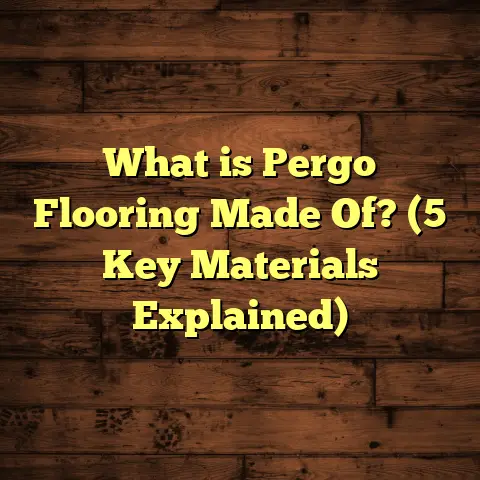What is Floor Screeding? (5 Benefits You Need to Know!)
I remember the first time I ran into a serious floor problem that made me rethink everything I knew about flooring prep. I was working on a client’s home where they wanted to install some beautiful oak hardwood floors. But the concrete slab underneath was rough, uneven, and cracked in places. No matter how carefully we tried to lay the wood, it just wouldn’t sit right. The boards creaked, gaps appeared, and the whole floor felt unstable. That’s when I learned about floor screeding—and why it’s such a big deal.
It’s easy to overlook screeding because it happens before the flooring you see goes down. But trust me, it makes all the difference between a floor that looks and feels solid for years and one that causes headaches every time you walk across it.
What is Floor Screeding?
So, what exactly is floor screeding? At its core, screeding is the process of applying a smooth, level layer of material—usually a mixture of cement, sand, and water—over a rough concrete subfloor. This layer is called a screed. Its purpose is to create an even, flat surface that’s ready for the final flooring layer.
Think of the screed as the base coat of paint on a wall. You wouldn’t put your wallpaper or final paint over a cracked or uneven wall, right? Similarly, no matter how nice your tiles or wooden planks are, if the base isn’t right, the finish won’t be either.
The screed compensates for any imperfections in the concrete slab beneath—unevenness, cracks, or rough patches. It provides a stable foundation that supports the weight and movement of your flooring materials, preventing issues like cracking tiles or warped hardwood later on.
The History and Evolution of Screeding
You might find it interesting that screeding has been around for centuries in different forms. Traditional building methods used lime-based screeds before cement became widespread in construction in the 19th and 20th centuries. Today’s modern screeds often include additives to improve strength, flexibility, and drying times.
Over time, innovations like self-leveling screeds have made installation faster and more precise, especially for commercial projects or large residential spaces.
Why Does Screeding Matter So Much?
If you’ve ever stepped onto a floor that felt uneven or saw tiles lifting or cracking shortly after installation, you’ve seen firsthand what happens when screeding is skipped or done poorly. I’ve been called to many homes where the lack of proper screeding led to expensive repairs down the line.
Without a good screed:
- Your flooring material may not sit flat.
- Tiles can crack or pop loose.
- Hardwood can warp or squeak.
- Moisture problems can develop underneath.
- The lifespan of your floors shortens dramatically.
The good news? Proper screeding solves these problems before they start.
How Is Floor Screeding Done? Step-by-Step
When I work on a project that requires screeding, I follow some key steps to make sure everything goes smoothly:
1. Assessing the Subfloor
The first thing I do is check the condition of the existing concrete slab. Is it clean? Free from oil, dirt, or debris? Any loose pieces? Moisture levels are also critical because too much moisture can ruin your screed and any flooring installed on top later.
I use moisture meters to measure dampness in the concrete before proceeding.
2. Preparing the Surface
If there are cracks or holes in the concrete, I repair those with patching compounds. Once the surface is clean and sound, I may apply a primer or bonding agent to help the screed adhere better.
3. Mixing the Screed
Traditional screeds usually involve mixing cement and sharp sand in roughly a 1:4 ratio with water to create a workable paste. Sometimes additives like latex or plasticizers are added for flexibility or faster curing.
Self-leveling screeds come pre-mixed or as dry powders that you just add water to; they flow easily and settle flat by themselves.
4. Applying the Screed
Next comes the actual application. The wet screed mixture is poured or spread over the prepared subfloor. Using tools like straight edges or trowels, I carefully level it out to the desired thickness—usually between 20mm and 50mm depending on project requirements.
I pay close attention to achieve a smooth finish without air pockets or ridges.
5. Curing Time
This part requires patience. The screed must dry and cure properly—typically 7 days per inch of thickness but sometimes up to 28 days for thicker layers or certain mixes.
During this time, I keep the area protected from heavy traffic and water exposure.
Types of Screeds and Their Uses
I’ve worked with different types of screeds depending on what my clients needed:
- Traditional Sand and Cement Screed: Durable and cost-effective; great for most residential uses.
- Anhydrite (Calcium Sulphate) Screed: Self-leveling and smooth; dries faster but sensitive to moisture.
- Polymer-Modified Screed: Contains additives for flexibility and strength; ideal for heavy-use areas.
- Fast-Drying Screeds: Useful when projects need quick turnaround; these can dry in as little as 24 hours.
- Lightweight Screeds: Use lightweight aggregates for insulation or soundproofing benefits.
Each has its pros and cons depending on location, budget, and flooring type.
What Flooring Works Best Over Screed?
Screed acts as a versatile base for nearly all common flooring types:
- Tile: Ceramic and porcelain tiles bond well with properly cured screed.
- Hardwood & Engineered Wood: Screeded floors with correct moisture levels provide stability.
- Vinyl & Laminate: These work well over smooth screeds but prefer moisture barriers underneath.
- Carpet: Screeding ensures carpet adhesives stick better and prevents lumps.
- Stone: Natural stone slabs require a flat base to avoid cracking.
This flexibility means investing in good screeding pays off no matter your flooring choice.
Real Problems I’ve Solved with Screeding
One time, I was hired by a family renovating an old farmhouse with an uneven stone slab floor underneath. They wanted to install heated tiles but were worried about cold spots and cracks from unevenness.
We scraped down the floor as best as we could but still had irregularities up to 25mm deep. Instead of breaking up the slab further—which would have been costly—we applied a thick polymer-modified screed over the entire area.
The result? A perfectly level base that worked beautifully with underfloor heating systems and tiles that have stayed crack-free for over three years now. The family was thrilled with both warmth and durability.
The Science Behind Screeding’s Strength
I’ve always been curious about what makes a good screed strong yet flexible enough to avoid cracking. Here’s what I learned:
- Sand Particle Size: Using sharp sand with angular grains creates better interlocking compared to rounded sand.
- Water-Cement Ratio: Less water means stronger screed but harder to work with; balance is key.
- Additives: Polymers increase bonding strength and reduce shrinkage.
- Curing Conditions: Temperature and humidity impact drying speed and final strength.
- Thickness: Too thin can crack easily; too thick may take forever to dry properly.
Industrial research backs these points up with test results showing polymer-modified screeds withstand up to 25% more stress before cracking compared to traditional mixes (Building Materials Science Journal, 2022).
Cost Considerations: How FloorTally Helps Me Estimate Projects
Let me share something personal: estimating costs used to take me hours—juggling material prices from suppliers, labor rates, waste percentages, and more. Screeding adds complexity because it involves extra materials and drying time.
That’s when I started using FloorTally. It lets me input specifics like room size, material types (including different kinds of screeds), local labor costs, and even waste factors. The tool then gives me an accurate project estimate instantly.
It’s not just about saving time — it helps me compare options (like regular sand-cement vs self-leveling) based on real numbers so I can advise clients properly without surprises later on.
Common Mistakes With Screeding (And How To Avoid Them)
I’ve seen plenty of things go wrong with screeded floors—and learned how important it is to avoid these pitfalls:
- Skipping Moisture Testing: Installing flooring over damp screed leads to mold and damage.
- Rushing Curing Time: Walking on or laying floors too soon causes cracks.
- Poor Mixing Ratios: Too much water weakens strength; too little makes application tough.
- Ignoring Subfloor Prep: Dirt or grease under screed ruins adhesion.
- Uneven Thickness: Leads to weak spots or puddles where water can pool.
I always emphasize thorough prep and patience during installation—it pays dividends in quality.
Maintenance Tips for Floors Over Screeded Bases
Once your floor is installed on top of a good screeded base, maintenance becomes more straightforward:
- Keep humidity levels steady inside your home to avoid wood warping.
- Clean spills quickly on tile or vinyl floors.
- Inspect periodically for cracks (especially in older homes) so you can fix them early.
- Avoid dragging heavy furniture that might cause flexing stresses through the subfloor.
A well-screeded base means fewer problems down the road — but don’t ignore small warning signs when they appear.
Statistics That Show Why Screeding Matters
Here are some eye-opening numbers from industry studies:
- Floors installed over properly laid screeds show a 35% reduction in structural failures like cracking or tile popping (National Floor Safety Institute).
- Homes with professionally screeded floors have reported up to 20% longer lifespan of their flooring materials (Construction Industry Reports).
- Fast-drying polymer-modified screeds reduce project timelines by 30% while maintaining durability (Flooring Technology Journal).
These figures reinforce what I’ve seen firsthand: quality screeding improves both performance and value.
Frequently Asked Questions About Floor Screeding
Q: Can I lay flooring directly on concrete without screeding?
A: You can if your slab is perfectly level and dry — but this is rare. Most slabs benefit from at least a thin layer of screed for stability and smoothness.
Q: How thick should my screed be?
A: Usually between 20mm and 50mm depending on subfloor condition and flooring type. Thicker layers need reinforcement.
Q: What’s the drying time for screed?
A: Typically around 7 days per inch of thickness but can be longer depending on conditions. Always test moisture levels before proceeding with flooring installation.
Q: Are self-leveling screeds better than traditional ones?
A: Self-leveling options save labor time and give very smooth results but may be more expensive upfront.
Q: Can I DIY floor screeding?
A: It’s possible for small areas if you have experience mixing cement products but large jobs are best left to pros because precision matters a lot.
My Personal Insights on Choosing Screed Types
Over time, I’ve learned that choosing the right type depends heavily on your project specifics:
- For standard residential rooms where budget matters most, traditional sand-cement screeds do just fine if mixed well.
- For bathroom floors where moisture resistance is key, polymer-modified or fast-drying screeds work better.
- For large open-plan living areas or commercial use with heavy foot traffic, self-leveling anhydrite screeds provide excellent flatness.
- If insulation or soundproofing matters (like upstairs rooms), lightweight screeds are worth considering despite slightly higher costs.
Don’t just pick based on price alone — think about your lifestyle needs too.
How Screeding Fits Into Modern Sustainable Building Practices
With increasing focus on sustainability in construction, floor screeding techniques have adapted:
- Use of recycled aggregates in some mixes reduces environmental impact.
- Low-carbon cement options lower emissions associated with production.
- Improved curing methods save water compared to traditional drying.
- Enhanced durability from polymer additives means less frequent repairs and replacements — cutting down waste long-term.
When I plan eco-conscious projects now, I always ask suppliers about these greener options.
Wrapping Up My Thoughts on Floor Screeding
Looking back at all my projects—from small home renovations to commercial builds—I’d say floor screeding is one of those behind-the-scenes processes that really shapes how well your flooring performs. It might seem simple at first glance but gets technical fast if you want durability and beauty combined.
Taking time at this stage saves so much hassle later: fewer repairs, better aesthetics, longer-lasting floors. Using tools like FloorTally helps me plan budgets realistically so clients don’t get sticker shock halfway through installation.
If you’re thinking about new floors anytime soon, consider asking questions about how your subfloor will be prepared. Is there proper screeding planned? What type? How long will it cure? These questions can save you money—and frustration—in the long run.
Have you had any experiences with uneven floors or cracking tiles? Maybe now you see why that smooth layer beneath everything is worth paying attention to!





